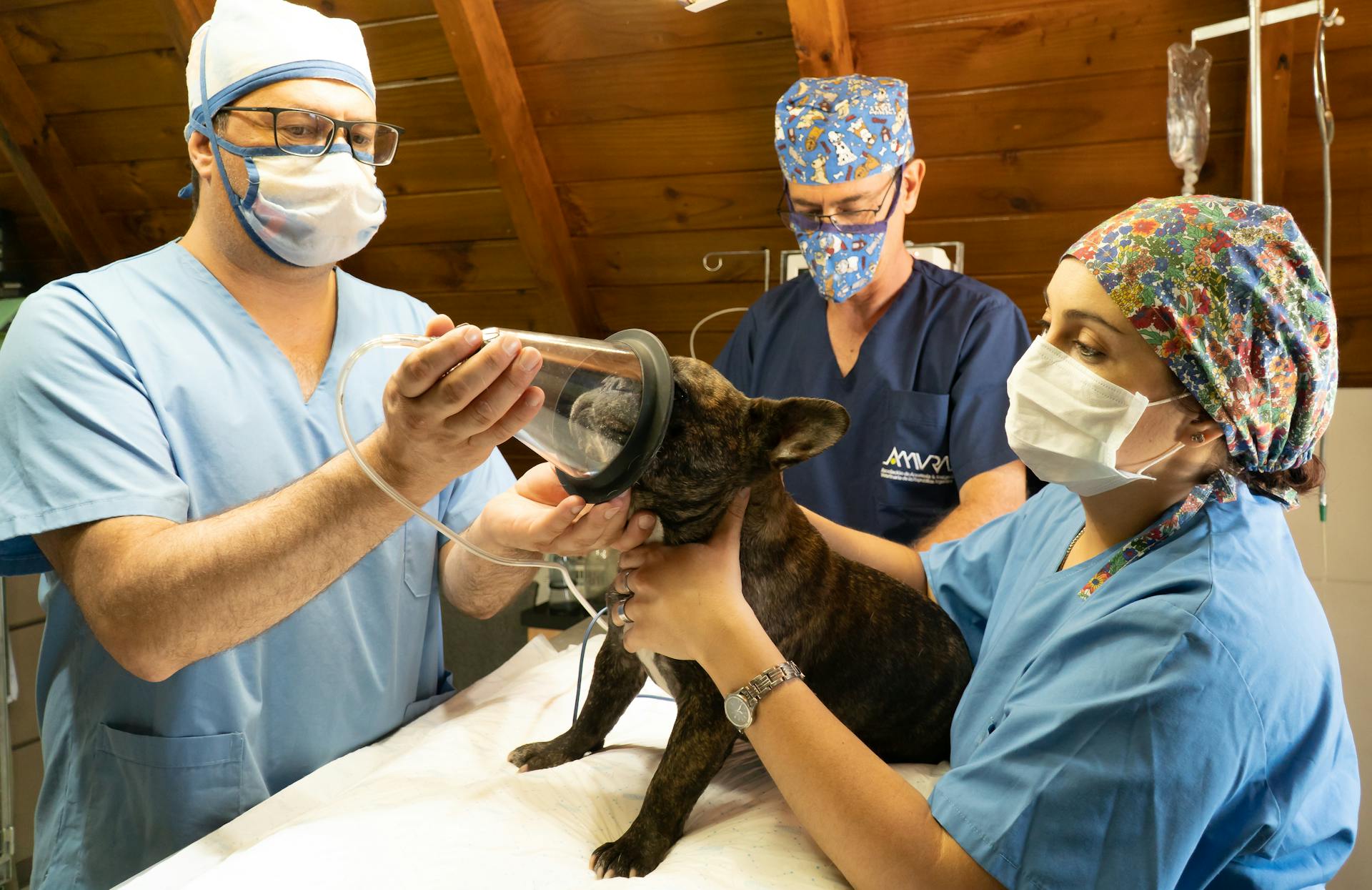
Preventing dog bloat is a top priority for any dog owner. The risk of bloat is higher in deep-chested breeds, such as Great Danes and German Shepherds.
Feeding large meals can increase the risk of bloat, so it's essential to divide your dog's daily ration into smaller, more frequent meals. This can help reduce the pressure on the stomach.
Not eating for a while can also trigger bloat, so it's crucial to maintain a regular feeding schedule. You can also consider adding a small amount of water to your dog's meals to help with digestion.
Exercise after meals can also contribute to bloat, so it's best to wait at least an hour before taking your dog for a walk.
Worth a look: Skin Relief for Dogs with Allergies
Understanding Bloat
Bloat is a serious medical condition that affects some dog breeds more than others.
Certain breeds are more prone to bloat, with Great Danes being one of the most at-risk due to their build and deep, narrow chests. Up to 40% of Great Danes will experience bloat at some point in their life.
Lean dogs are more likely to experience bloat than overweight dogs.
Aggressive and fearful dogs tend to suffer from bloat more often than happier canines, and stress can exacerbate the condition.
Broaden your view: Dog Breeds Watch Dogs
Causes of Bloat
Stress can be a significant contributor to bloat in dogs, as it can impair their gastrointestinal functioning and lead to digestive issues.
Kenneling or long car rides can be particular stressors that may trigger bloat in dogs.
Inflammatory bowel disease, food allergies, and other disorders that slow down gut movement can also contribute to the development of GDV.
What's in Dogs
Bloat in dogs is a serious condition that can be deadly if not treated promptly. It's a good idea to know the breeds that are more likely to bloat, as some are at higher risk than others.
Certain breeds are more prone to bloat, but the exact cause is still not fully understood. However, research suggests that some breeds are more susceptible to GDV due to their physical characteristics.
Bloat can happen in as little as 20 minutes, which is why it's crucial to act fast if you suspect your dog is bloating. The faster you seek veterinary attention, the better the chances of saving your dog's life.
You might like: Breeds of Dogs with Rear Dew Claws
A flipped stomach or Gastric Dilatation-Volvulus (GDV) can cause the pancreas and spleen to flip with it, cutting off blood flow to vital organs. This can send your dog into shock, making it a medical emergency.
Conditions such as inflammatory bowel disease, food allergies, or other disorders that slow down gut movement may contribute to the development of GDV. Identifying and treating these underlying conditions can help prevent future episodes of bloat.
Stressors That Cause Bloat
Stress can be a major contributor to bloat in dogs. Stress adversely affects gastrointestinal functioning, leading to impaired digestive systems.
Kenneling or long car rides can be stressful for dogs and may be a contributing factor to bloat. Stressful events in the 8 hours before a GDV occurrence can include boarding, pet sitters or strangers in the house, excessive exercise, vet visits, traveling, and moving to a new house.
These stressful events can cause a dog's stomach to twist, leading to GDV or bloat. The stomach twists anywhere from 180 to a full 360 degrees, blocking both entry and exit.
Here are some common stressors that can lead to bloat:
- Boarding
- Pet sitter or strangers in the house
- Excessive exercise
- Vet visits
- Traveling
- Moving to a new house
It's essential to minimize stress in your dog's life to reduce the risk of bloat.
Preventing Bloat
Preventing bloat in dogs is crucial, as it can be a life-threatening condition. There are several ways to reduce the risk of bloat, starting with feeding habits.
Scheduled feeding is safer than free-feeding, allowing you to monitor how much your dog eats. Some dogs that eat quickly may need to be slowed down with a slow feeder bowl. Recent research has found that elevated dog bowls do not prevent bloat and may even increase the risk.
Feeding your dog two or more small meals a day instead of one large meal can also help prevent bloat. Including canned food in your dog's diet can also reduce the risk. Limiting exercise after meals and avoiding stress can also help prevent bloat.
Here are some precautions you can take to prevent bloat in dogs:
- Avoid stress
- Feed your dog two or more small meals a day
- Include canned food in your dog’s diet
- Limit exercise after meals
- Avoid using elevated food dishes
- For predisposed breeds, preventative gastropexy may be recommended
Be Prepared
Certain breeds are more prone to experiencing bloat than others, but all dogs can develop this life-threatening condition at some point in their lives. Changing feeding habits and diet can reduce the risk.
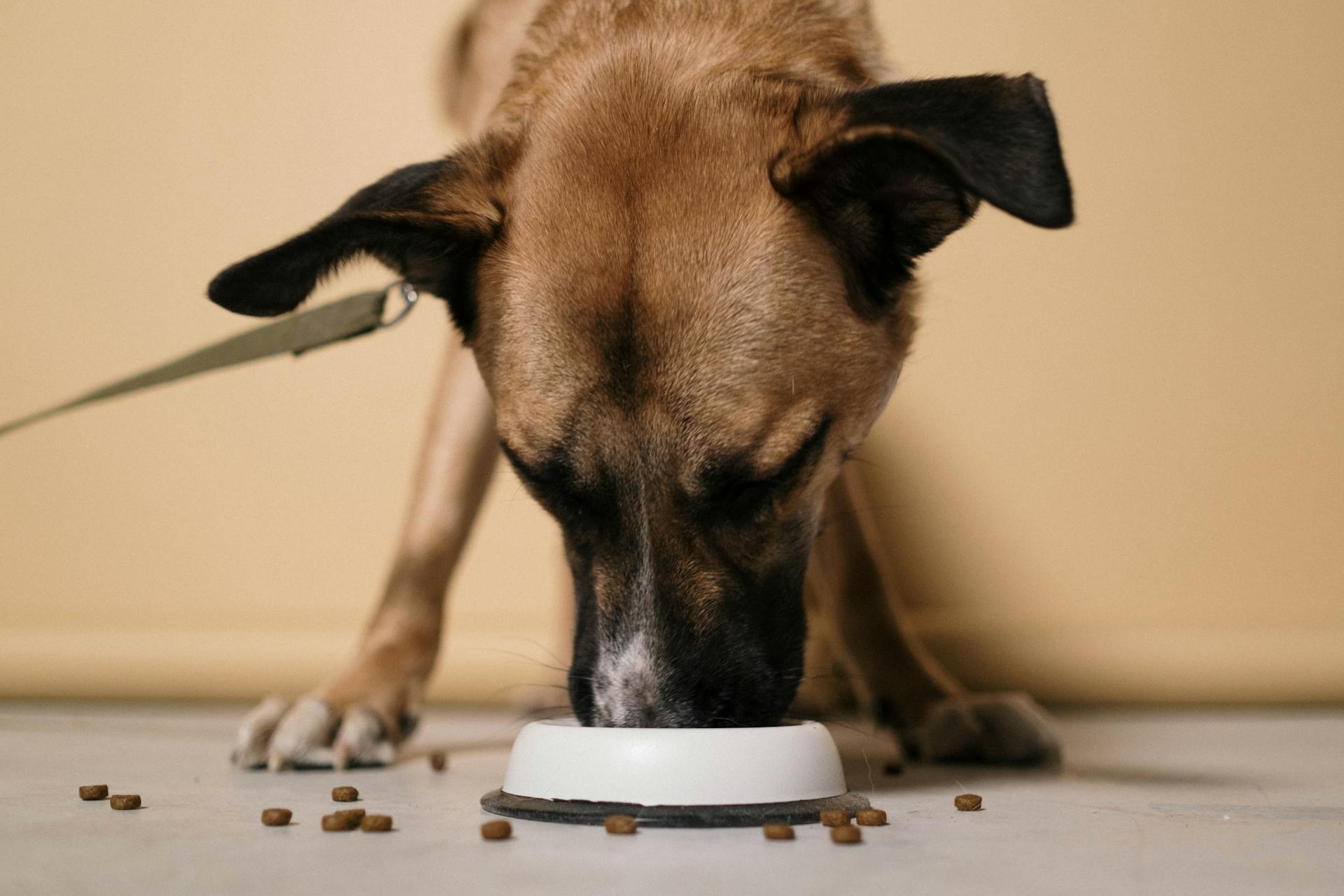
Low-carbohydrate diets can help reduce gas production, which is a major contributor to bloat. A study found that dogs who ate dry foods with fats among the first four ingredients had a 170% increase in GDV.
To prevent bloat, it's essential to slow down eating. This can be achieved by feeding multiple small meals throughout the day or using a slow-feeder bowl.
Feeding a fresh, whole food, raw meat-based diet is ideal for preventing bloat. Your dog's digestive tract is designed for meat, not grains and starches.
Some dry food choices are especially bad for your dog's health. Kibble that has fat in the first 4 ingredients increases your dog's risk by 170%, and kibble that contains citric acid increases bloat risk by 320% if you moisten it before feeding.
If you can't feed raw, choose a less processed, lower starch option like freeze-dried raw, dehydrated or air dried, canned food, or a home-cooked diet.
Here are some risk factors to be aware of:
- First-degree relatives that have had GDV
- Stress
- Lean body condition
- Advancing age
- Fearful / nervous / aggressive temperament
- Eating quickly
- Eating only dry food
- Eating one large meal a day
These risk factors suggest that both genetics and environmental factors play a role in the development of GDV.
Preventing
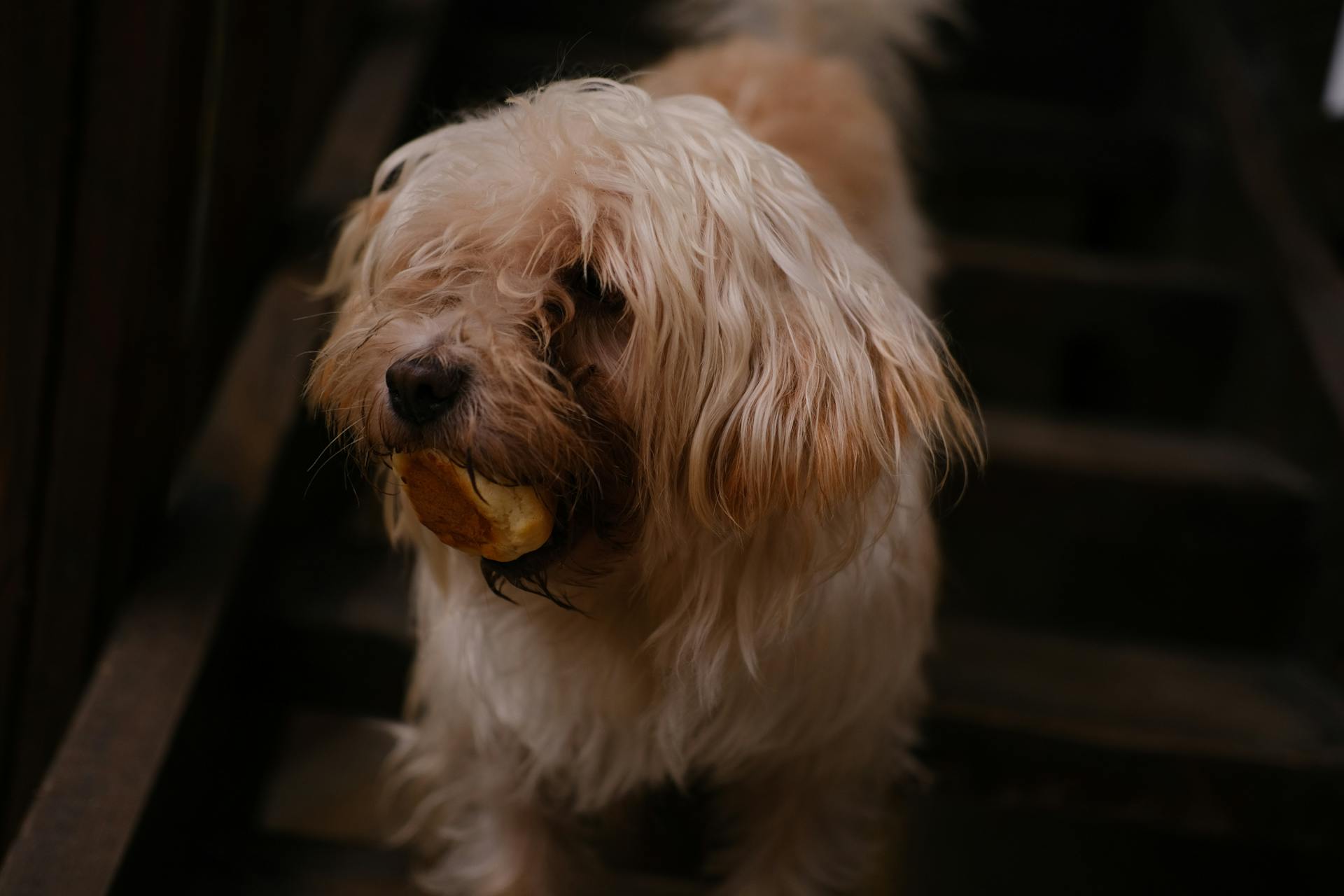
Preventing bloat in dogs requires a multi-faceted approach that includes changes to their diet, exercise habits, and living environment. Stress can be a significant contributor to bloat, so it's essential to minimize your dog's stress levels.
Scheduled feeding is a safer option than free-feeding, allowing you to monitor your dog's intake and prevent overeating. Some dogs may need to be slowed down with a slow feeder bowl.
Feeding your dog two or more small meals a day instead of one large meal can help reduce the risk of bloat. Adding canned food to their diet can also make a significant difference.
Exercise should be avoided immediately before and after meals, especially if it's a vigorous activity. This allows your dog's stomach to digest food without the risk of twisting or turning.
Limiting water intake before and after meals can also help prevent bloat. Giving your dog small amounts of water at a time can help them drink slowly and avoid gulping air.
Curious to learn more? Check out: Service Dog Vest for Small Dogs
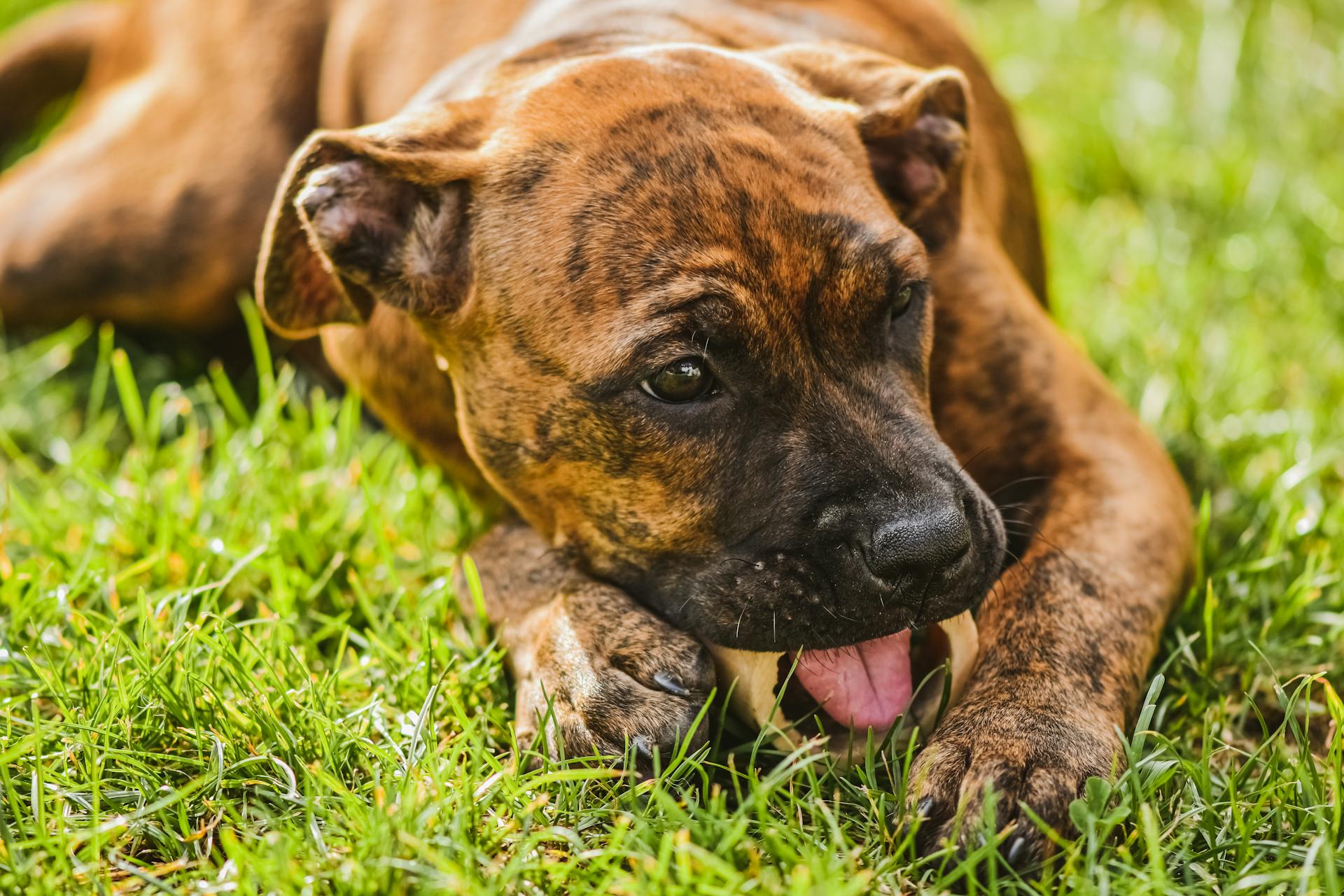
Avoiding elevated food dishes can help prevent faster consumption, which can contribute to bloat. Raised food bowls have been associated with an increased incidence of GDV, so it's best to avoid them.
Here are some precautions you can take to reduce the risk of bloat in your dog:
- Avoid stress
- Feed your dog two or more small meals a day
- Include canned food in their diet
- Limit exercise after meals
- Avoid using elevated food dishes
- For predisposed breeds, preventative gastropexy may be recommended
By making these changes and being mindful of your dog's eating habits and exercise routine, you can significantly reduce the risk of bloat and keep your furry friend safe and healthy.
Breed-Specific Risks
Some breeds are more prone to bloat than others. Large or giant breeds, such as Great Danes, Doberman Pinschers, and Standard Poodles, are at higher risk of GDV.
While these breeds are more susceptible, it's essential to remember that bloat can happen to any breed or size of dog. So, even if your dog isn't on this list, it's still crucial to be aware of the signs of bloat.
Here are some breeds that are more prone to bloat:
Breeds Prone to
Some breeds are naturally more prone to bloat, a life-threatening condition that requires immediate attention. Large and giant breeds are at a higher risk, including Great Danes, Doberman Pinschers, Standard Poodles, and Irish Wolfhounds.
Dogs with a family history of bloat are also more likely to experience it, so it's essential to ask your breeder about your dog's family history. This knowledge can help you take extra precautions to prevent bloat.
Here are some breeds that are more susceptible to bloat:
- Great Danes
- Doberman Pinschers
- Standard Poodles
- Irish Wolfhounds
- Akitas
- German Shepherds
- Golden Retrievers
- Weimaraners
- Saint Bernards
- Boxers
- Basset Hounds
- Old English Sheepdogs
- Irish Setters
Remember, even if your breed isn't on this list, it's still possible for your dog to experience bloat. Always be aware of the signs and take preventive measures to reduce the risk.
A Note for Breeders
As a breeder, you have a unique opportunity to impact the health and well-being of your dogs by making informed decisions about their breeding. Research shows that knowingly breeding a first-degree relative of a dog who's had Gastric Dilatation-Volvulus (GDV) could reduce the incidence of GDV by 60%.
Intriguing read: Healthy Mind Canine - Separation Anxiety Training
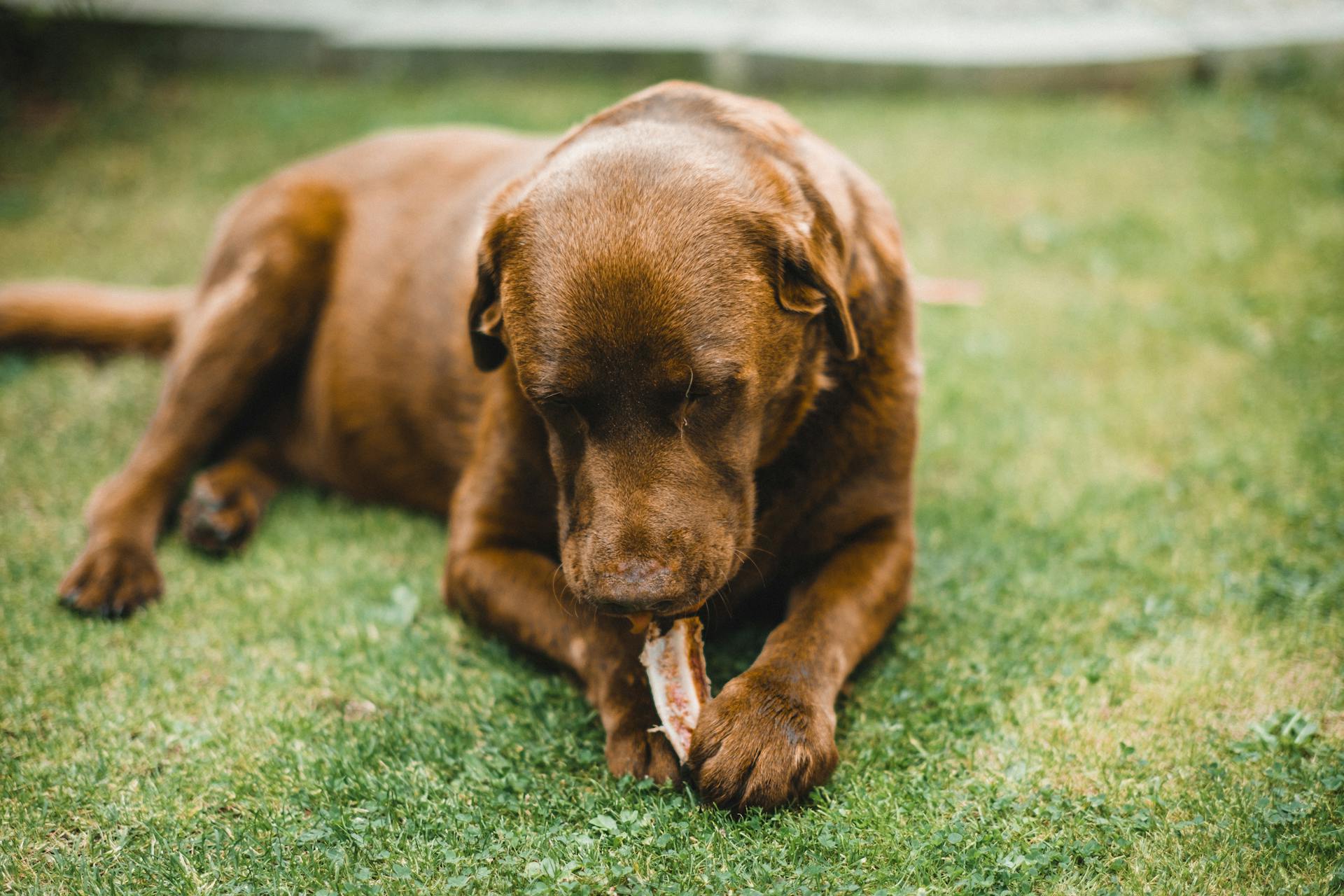
This is a significant reduction in risk, and it's essential to consider this factor when making breeding decisions. By avoiding breeding dogs with a history of GDV, you can help prevent this potentially fatal condition in your breeding line.
To put this into perspective, even with medical intervention, 25% to 30% of dogs still die from GDV. This emphasizes the importance of taking proactive steps to prevent this condition.
Here are some key statistics to consider:
Symptoms and Diagnosis
Symptoms of bloat can be a real concern for dog owners. Bloat can come on very fast, so it's essential to be aware of some common symptoms.
Agitation is a classic sign of bloat, often manifesting as panting, whining, or pacing. Head hanging and stiff movement can also be indicative of a bloat issue.
Shaking or shivering can be a sign of discomfort or pain in the abdomen. Burping and drooling are also common symptoms of bloat.
Trying to vomit (unsuccessfully) is another alarming sign of bloat. A bloated abdomen is a clear visual indicator of the problem.
You may also notice signs of abdominal discomfort or pain, which can range from mild to severe. Shock and collapse/loss of consciousness are extreme symptoms that require immediate attention.
If you notice any of these symptoms, it's crucial to seek veterinary care right away. Bloat often happens right after your dog eats, making mealtime a critical window for monitoring your dog's behavior.
Treatment and Prevention
To prevent dog bloat, it's essential to feed your dog two or more small meals a day instead of one large meal. This can help reduce the risk of bloat.
Avoiding stress is also crucial in preventing dog bloat. Stress can cause your dog to eat more quickly, which can lead to bloat.
Including canned food in your dog's diet can help prevent bloat. Canned food is often easier to digest than dry food, which can reduce the risk of bloat.
Intriguing read: Can Stress Cause Pancreatitis in Dogs
Limiting exercise after meals is also important. Exercise can cause your dog to swallow air, which can lead to bloat.
Elevated food dishes can make your dog eat faster, so it's best to avoid using them.
For breeds that are predisposed to bloat, preventative gastropexy may be recommended. This is a surgical procedure that can help prevent bloat from occurring.
Here are some key things to remember:
- Feed your dog two or more small meals a day
- Avoid stress
- Include canned food in your dog’s diet
- Limit exercise after meals
- Avoid using elevated food dishes
- For predisposed breeds, preventative gastropexy may be recommended
Frequently Asked Questions
Should I get my German Shepherds stomach tacked?
If your German Shepherd has a family history of gastric torsion or a deep chest, stomach tacking may be a recommended preventative measure to consider. Consult with a veterinarian to determine if stomach tacking is right for your dog.
Sources
- https://wagwalking.com/wellness/how-to-prevent-bloat-in-your-dog
- https://www.preventivevet.com/dogs/prevent-dog-bloat-gdv
- https://www.dogsnaturallymagazine.com/preventing-bloat-in-dogs-naturally/
- https://www.eastvalleyanimal.com/how-to-prevent-bloat-in-dogs/
- https://www.smalldoorvet.com/learning-center/medical/bloat-in-dogs
Featured Images: pexels.com

